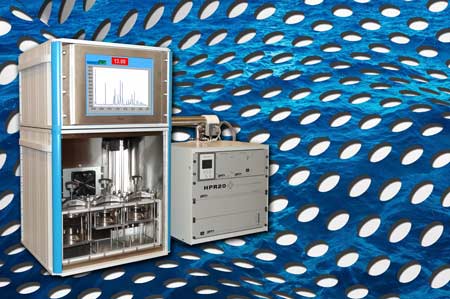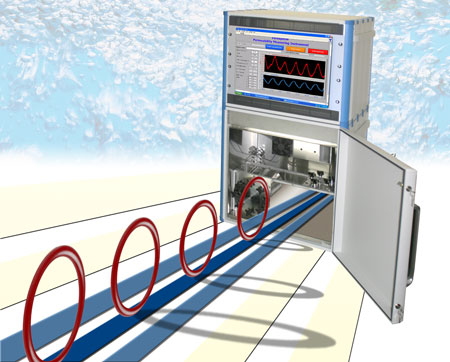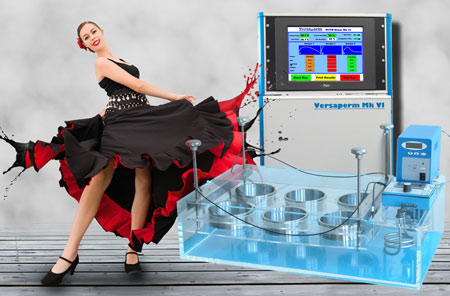

 Our laboratory based vapour permeability testing and measurement service can deal with water vapour (H2O), O2, N2, H2, CO2, He, argon, aromatics and hydrocarbons and every other every non-proscribed gas. We can measure the vapour permeability of virtually any material, flat samples, laminates, manufactured components, containers or systems.
Our laboratory based vapour permeability testing and measurement service can deal with water vapour (H2O), O2, N2, H2, CO2, He, argon, aromatics and hydrocarbons and every other every non-proscribed gas. We can measure the vapour permeability of virtually any material, flat samples, laminates, manufactured components, containers or systems.
There is no reliable way of predicting the actual vapour permeability properties of a finished product or enclosure simply by knowing the materials it is made from. The manufacturing processes themselves can alter a component's permeability by at least a factor of four. This leaves just two options - the “educated guess method” and vapour permeability testing.
Our laboratory offers modern equipment based vapour permeability testing and Standards based testing techniques.
The testing process is based on using conditions of high vapour concentration (at a particular temperature) to one side of a material, and measuring how much vapour permeates through to the other side. Today this is usually measured using electronic sensing and measuring techniques but many local and international Standards are still based on the gravimetric technique. Naturally, Versaperm can use either testing regime.
Today, instrumental techniques, such as WVTR meters, offer fast and accurate results on most materials. Many sensor types and techniques are available click here for details.
 Testing materials
Testing materialsA common way to test materials is to use flat samples – which can be anything from a foil barrier through to plastics, paper or coatings or the blisters in a unitary dose blister pack. Our testing can give results for any non-proscribed vapour including H2O, O2, N2, H2, CO2, He, argon, aromatics and hydrocarbons. The fastest and most cost-effective way of measuring this is using an instrumental technique, but standards based testing is also available.
We can measure vapour permeability for enclosures (such as electronics enclosures, pharmaceutical capsules), click-fit or threaded enclosures, secondary containers, solid seals or packaging. This includes tubs, sachets, tubes, bottles and manufactured containers which can be tested under a range of environmental conditions including temperature and mechanical pressures and dynamic conditions such as diurnal and seasonal changes.
There are two ways to test the permeability of these enclosures. The most reliable technique is to include a vapour source in a container before sealing it . The alternative involves passing the vapour through the enclosure itself and placing it in a controlled chamber.
We can test almost any part or component – either by using a specially manufactured jig to hold it, or by sealing off parts of the item using a virtually non-permeable material.
We have tested the vapour permeability of countless film and laminate materials and products. Most polymers offer very good resistance to liquid water but their resistance to water and other vapours, such as oxygen, carbon dioxide, nitrogen or argon etc can be extremely variable, for example EVOH, PVOH and cellulose offer, at best, a minimal barrier to water vapour and should not be used in many applications. The best vapour barrier films are laminates,which often include aluminium, either as a discrete layer or as a result of a metallisation process.
PVC or Polyvinyl Chloride is widely used – though it provides a nominal or zero barrier to moisture.
PP or polypropylene are economical medium-moisture barrier materials.
PVC/PCTFE laminations involve a thermoplastic film laminated to the PVC by adhesive or heat sealing, sometimes with an intermediate polyethylene layer. Various thickness of laminate provide average-to-extreme moisture barriers.
Saran or cling film is a PVC/PVdC film coated with polyvinylidene chloride (PVdC). The coating provides a medium to high vapour barrier.
COC or cyclic olefin copolymers are a relatively new family of polymers that offer excellent barrier for applications where halogen free packaging is required. COCs are often laminated between layers of PE or PP.
Cold form foil is used where products are extremely sensitive to either water or light. It provides an extreme moisture barrier and is constructed using three layers: PVC, aluminium foil, and nylon.
We have many decades of experience at testing coatings that can be used to protect the substrate such as paper, plastic, water or metal. Measuring the vapour permeability of most coatings is relatively simple and can be typically completed without complications.
While metal tubing is typically impervious to water vapour, most types of plastic tubing will permit vapours such as water, air, medical or automotive gases to pass through. This can be completely disastrous in an ultra-dry laboratory instrument. The testing of plastic tubing is specialised, and can provide surprising results.
 Gaskets, O-rings and Foam Seals
Gaskets, O-rings and Foam SealsWe can test the permeability of gaskets, O-rings and foam seals against any non-proscribed gas under a huge range of compressions, temperatures and other environmental conditions. Different compression levels usually offer varied resistance to vapours – either to much or too little pressure can reduce effectiveness.
Special care and very specific testing regimes are required when testing against specific standards. Below is a brief list of some of the main standards we can test against. Our measurement and testing systems equipment is used in various national standards laboratories around the world..
 Additional WVTR standards:
Additional WVTR standards:Our gravimetric testing uses standards based techniques which require measuring the weight gain of a water-absorbing material in the dry part of the test rig. It is used mainly for measuring technical textiles.
For information on permeability testing click here
For background information on permeability click here